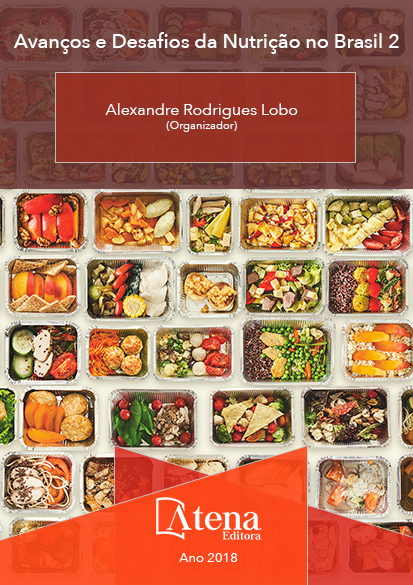
QUALIDADE TECNOLÓGICA, NUTRICIONAL E FUNCIONAL DE SORVETE ARTESANAL DE LIMÃO SICILIANO ELABORADO COM AZEITE DE OLIVA EXTRA-VIRGEM COMO PRINCIPAL INGREDIENTE LIPÍDICO
O azeite de oliva extra-virgem
apresenta propriedades benéficas à saúde,
atribuídas ao teor elevado de ácidos graxos
monoinsaturados e de compostos fenólicos.
Em função da termossensibilidade desses
compostos, o caráter inovador da utilização do
azeite em sobremesas, que não são submetidas
ao aquecimento, tem sido investigado. Esses
estudos embasam a criação de uma estratégia
para aproveitamento do potencial funcional
dessa matriz alimentar. Objetivou-se elaborar
sorvete artesanal de limão siciliano utilizando
azeite de oliva extra-virgem. Duas formulações
de sorvete foram elaboradas com azeite de oliva
extra-virgem (18%, p/ p): com azeite brasileiro
(SAB) e com azeite grego (SAG). A estabilidade
dos sorvetes foi avaliada através do cálculo da
taxa de derretimento, da incorporação de ar, e da
densidade aparente. A capacidade antioxidante
(CAO) foi determinada por Folin-Ciocalteau
e FRAP. As duas formulações apresentaram
estabilidade até 45 minutos. O overrun foi de
19% em SAB e 28% em SAG. A densidade
aparente foi de 740 g/L em SAG e 780 g/L em
SAB. Não houve diferença estatística para a
CAO dos azeites e dos sorvetes. A CAO de
SAG e SAB, avaliada por Folin-Ciocalteau foi
de 46 ± 12 e 62 ± 11 mg de ácido gálico/ 100 g,
respectivamente. Quando avaliada por FRAP, a
CAO de SAG e SAB foi de 194 ± 32 e 196 ± 2
mmol de Fe+2/ 100 g, respectivamente. Concluiuse
que as duas formulações apresentaram
boas características de incorporação de ar e de
derretimento, e boa estabilidade dos compostos
fenólicos e da capacidade antioxidante.
QUALIDADE TECNOLÓGICA, NUTRICIONAL E FUNCIONAL DE SORVETE ARTESANAL DE LIMÃO SICILIANO ELABORADO COM AZEITE DE OLIVA EXTRA-VIRGEM COMO PRINCIPAL INGREDIENTE LIPÍDICO
-
DOI: 10.22533/at.ed.94918021232
-
Palavras-chave: alimento funcional; óleo de oliva extra-virgem; compostos fenólicos; FRAP
-
Keywords: functional food; extra-virgin olive oil; phenolic compounds; FRAP
-
Abstract:
Extra-virgin olive oil presents health benefits attributed not only to the
high content of monounsaturated fatty acids, but also to the presence of phenolic
compounds. Due to the thermosensitivity of these compounds, the innovative character
of olive oil use in desserts, especially in those that are not subjected to heating, has
been increasingly investigated. These studies represent important tools for the creation
of a strategy to take advantage of the total functional potential of this food matrix.
Therefore, it was aimed to elaborate artisanal sicilian lemon ice cream using extravirgin
olive oil. Two formulations of ice cream were made with extra virgin olive oil (18%,
w / w) of the Koroneiki variety, one of them with Brazilian olive oil (SAB) and another
with Greek olive oil (SAG). The stability of the ice creams was evaluated by melting
rate, overrrun and apparent density. The antioxidant capacity was determined by Folin-
Ciocalteau and FRAP (Ferric Reducing Antioxidant Power). The two formulations
showed stability up to 45 minutes. The overrun levels were 19% for SAB and 28% for
SAG. The apparent density of SAG was 740 g / L and of SAB, 780 g / L. There was
no statistical difference for the antioxidant capacity of the oils and the ice cream. The
antioxidant capacity of SAG and SAB, evaluated by the Folin-Ciocalteau assay, was
46.2 ± 11.7 and 61.6 ± 10.8 mg of gallic acid/ 100 g, respectively. When evaluated by
FRAP, the antioxidant capacity of SAG and SAB was 194.1 ± 31.7 and 196.1 ± 2.4
μmol of Fe+2/ 100 g, respectively. It was concluded that the two formulations presented
good characteristics of air incorporation and melting, and good stability of the phenolic
compounds and the antioxidant capacity.
-
Número de páginas: 15
- Lilia Zago


